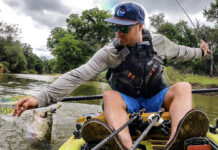Striped bass are native to the New England and mid-Atlantic coast, but the anadromous fish can live in fresh or saltwater. In the past century, thousands of stripers have been stocked in lakes and rivers all over the United States. Late summer can be the best time to target striped bass as the fish school up and move into tributaries to spawn.
How to Catch Striped Bass Just About Anywhere
Water temperature is one of the most important keys to finding striped bass. The fish suffer in water above 70ºF. For the best action, I look for water between 57 and 65ºF.

The coolest water will be in deep holes, cool springs and creek mouths. Water released from an up-river dam can also send cool water into the lake. The best time to find cooler water is dawn, dusk and overnight; I spend a lot of time fishing in the dark.
Once I locate the best water temperature, I look for a current break, log jam, large rock, bend in the river or eddy behind an island where the striped bass can escape the current and hide from baitfish. When I catch a striper, I work the same area thoroughly. Where there’s one striped bass there are sure to be more.
Striper Rods and Lures
When spotting a striper feeding on the surface
I use a topwater like Tactical Anglers’ Crossover matched to the size and color of the bait the striper are chasing. To quickly switch lures from deep to shallow to topwater, I tie a 50-pound Tactical Anglers power clip between the line and the lure. The clip also improves the lure’s action.
When the summer heat slows the bite
I’ll switch to natural bait rigged on a circle hook. In the south, gizzard shad are the bait of choice for striped bass. It’s possible to catch live bait with a cast net, but I purchase fresh shad from my local bait shop, Striper Soup in Acworth, Georgia. Rig a seven-to nine-inch live bait on a 5/0 circle hook and cast it into the striper’s den. For cut bait, I use a Carolina rig with enough lead to hit bottom.
Striped bass range from school-sized fish around five pounds to trophies over 50 pounds. I choose a medium-heavy rod, beefy conventional reel spooled with 60-pound braided line and a 30-pound fluorocarbon leader. This set-up will fish live bait or artificial lures.
For artificial lures, I choose an albino or white Zoom Magnum Super Fluke on a 3/8 to one-ounce jighead or a white bucktail to target deep holes and structure. Drop the lure and bounce it on the bottom with a hop, hop, pause action.
Fishing Deadfalls, Structures or Shallow Water
I use the same Super Fluke rigged weedless on a 3/8-ounce jighead. I’ll also cast a large swimbait or wake bait and retrieve by popping a couple times then pausing for a few seconds.
Fishing a Current Break
I anchor up current and cast a Cotton Cordell Red Fin or Tactical Anglers SubDarter at a 45-degree angle and let it sweep into the strike zone.
Like their coastal cousins, river and lake striped bass are easy to catch once you figure out their patterns. Learning their habits and preferences will untangle the mystery of striper fishing in your local water.
In the past century, thousands of stripers have been stocked in lakes and rivers all over the United States. | Feature photo: Gong Lei






